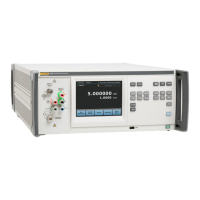5790B
Service Manual
A-8
Sensitivity
The degree of response of a measuring device to the change in input quantity, or
a figure of merit that expresses the ability of a measurement system or device to
respond to an input quantity.
Settling Time
The time taken for a measurement device's reading to stabilize after a voltage is
applied to the input.
Shield
A grounded covering device designed to protect a circuit or cable from
electromagnetic interference. Also see “guard”.
SI System of Units
The accepted International System of Units. See also “units”, “base units”, and
“derived units”.
Specifications
A precise statement of the performance of a measurement or stimulus device.
Square Law
Defines the response of a device whose output is proportional to the square of
the applied stimulus. Thermocouple-type transfer devices have a square-law
response.
Stability
A measure of the freedom from drift relative to a reference value, over time and
over changes in other variables such as temperature. Note that stability is not the
same as uncertainty.
Standard
A device that is used as an ext value for reference and comparison.
Standard Cell
A primary cell that serves as a standard of voltage. The term “standard cell” often
refers to a “Weston normal cell”, which is a wet cell with a mercury anode, a
cadmium mercury amalgam cathode, and a cadmium sulfate solution as the
electrolyte.
Systematic Error
Any error that remains constant or varies in a predictable manner as successive
measurements of the same quantity are made under effectively identical
conditions. Note that a known systematic error can be compensated for with a
correction, whereas, a random error cannot. Also see “random error”.
Temperature Coefficient
A factor used to calculate the change in indication or output of an instrument as a
result of changes in temperature. Changes in temperature contribute to
instrument uncertainty by an amount determined by the temperature coefficient.

